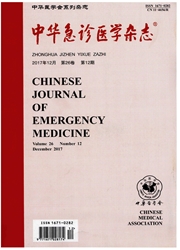

 中文摘要:
中文摘要:
目的 观察心肺复苏后输注4 ℃盐水降温对心肌组织超微结构的影响.方法 12只实验用北京长白猪,在朝阳医院动物实验室进行实验,直流电击诱导心室颤动,在室颤4 min后进行心肺复苏.复苏成功的猪10只,随机(随机数字法)分为2组:低温组(n=5)(4 ℃生理盐水静脉输注降温)与对照组(n=5),监测血流动力学指标,并在电镜下观察心肺复苏后24 h心肌组织超微结构.统计方法采用两个样本的秩和检验.结果 复苏前后两组HR,MAP,CO差异无统计学意义(P>0.05);心肺复苏后24 h,对照组心肌肌丝断裂,线粒体空泡样变、嵴断裂;低温组心肌肌丝排列整齐,肌节清楚,线粒体结构清晰.结论 心肺复苏后静脉输注4 ℃盐水对心肌具有保护作用.
 英文摘要:
英文摘要:
Objective To observe the myocardial injury attributed to cardiopulmonary resuscitation, and to evaluate the impact of 4 ℃ saline perfusion on the ultra structure of myocardium. Method Twelve Pekimg white swine were induced to make models of ventricular fibrillation by direct current shock. Cardiopulmonary resuscitation was initiated 4 minutes after ventricular fibrillation established, and 10 swine survived from resuscitation. These swine were randomly(random number ) divided into hypothermia group ( n = 5) ( 4 ℃ saline infusion to lower the temperature) and control group ( n = 5). Haemodynamics were monitored. And ultra structure of myocardium was observed under electron microscope 24 hours later. The Mann-Whitney test was used to compare the consecutive variables of 2 samples. Results The damage to the ultra structure of myocardium, myofilaments and mitochondria, was found in the control group, while that to a much lesser extent in the hypothermia group was observed. Conclusions After cardiopulmonary resuscitation, 4 ℃ saline infusion has a protective effect on myocardium.
 同期刊论文项目
同期刊论文项目
 同项目期刊论文
同项目期刊论文
 Effect of continuous compressions and 30:2 cardiopulmonary resuscitation on global ventilation/perfu
Effect of continuous compressions and 30:2 cardiopulmonary resuscitation on global ventilation/perfu Mild Hypothermia Attenuates Mitochondrial Oxidative Stress by Protecting Respiratory Enzymes and Upr
Mild Hypothermia Attenuates Mitochondrial Oxidative Stress by Protecting Respiratory Enzymes and Upr Cerebrospinal fluid biochemistry reflects effects of therapeutic hypothermia after cardiac arrest in
Cerebrospinal fluid biochemistry reflects effects of therapeutic hypothermia after cardiac arrest in Effect of rescue breathing during cardiopulmonary resuscitation on lung function after restoration o
Effect of rescue breathing during cardiopulmonary resuscitation on lung function after restoration o Load-distributing band improves ventilation and hemodynamics during resuscitation in a porcine model
Load-distributing band improves ventilation and hemodynamics during resuscitation in a porcine model 期刊信息
期刊信息
